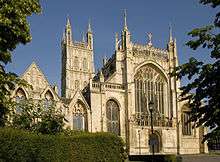Gloucester Abbey


Gloucester Abbey was a Benedictine abbey in the city of Gloucester, England. Since 1541 it has been Gloucester Cathedral.
A Christian place of worship had stood on the abbey site since Anglo-Saxon times. Benedictine rule was introduced about 1022 and the abbey dedicated to St Peter. [1] The fraternity was invigorated when King William I appointed the energetic Norman monk Serlo to be the abbot. Serlo built the impressive abbey Church of St Peter.[2]
In the Middle Ages the abbey became rich and powerful. King Henry III was crowned there in 1216 at the age of nine. King Edward II, who had died in nearby Berkeley Castle, was buried there in 1327 and a shrine erected over his tomb. The additional funds this generated enabled the east end of the church to be rebuilt in the new perpendicular style and the west end to be remodelled. Later work created the south porch and the present tower and Lady Chapel.
It is recorded that the abbey lost about a quarter of its complement of monks in 1377 due to the Black Death. In 1378, when Parliament was held in Gloucester, the king stayed at the abbey.
On 2 January 1540, the abbey was dissolved by Henry VIII as part of the Dissolution of the Monasteries and granted to the newly created Bishop of Gloucester who had previously been the last Abbot of Tewkesbury Abbey. It became The Cathedral Church of Saint Peter and the Holy and Indivisible Trinity in Gloucester the following year.[3]
Many of the former abbey buildings have been Grade I listed, including the Cathedral, the Cathedral Cloisters, Cathedral Treasury and the Cathedral Chapter House, together with the Little Cloister, Little Cloister House, the Infirmary and Church House, the former Abbot's Lodging.
Notable burials
Notable people buried in St Peter's Abbey included:
- Osric, king of the Hwicce
- Robert Curthose, eldest son of William the Conqueror (c.1051–1134)
- Edward II of England, seventh Plantagenet king of England (1307–1327).
- Walter Froucester (died 1412), Abbot of Gloucester
- Walter de Lacy (died 1085), Anglo-Norman baron
- Bernard de Neufmarché (c.1050–c.1125), Norman Lord, creator of Breconshire.
- Roger de Pitres (died bef. 1083), Norman Constable of Gloucester Castle
See also
References
- ↑ Knowles, David; Brooke C. N. L.; and London, Vera C. M. The Heads of Religious Houses: England and Wales 940–1216 Cambridge: Cambridge University Press 1972 ISBN 0-521-08367-2 p. 52
- ↑ "Cathedral History". Gloucester Cathedral. Retrieved 1 November 2016.
- ↑ "Gloucester Cathedral – History". Retrieved 2009-03-01.
Coordinates: 51°52′3″N 2°14′48″W / 51.86750°N 2.24667°W